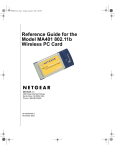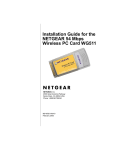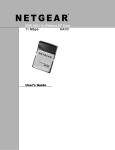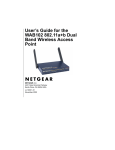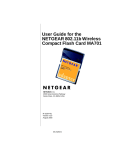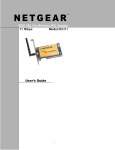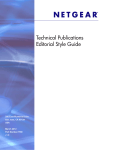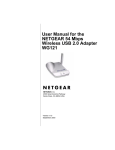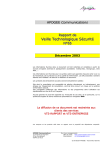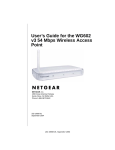Download Netgear MA101 Reference Manual
Transcript
Reference Manual for the Model MA101 802.11b Wireless PC Card NETGEAR, Inc. 4401 Great America Parkway Santa Clara, CA 95054 USA Technical Support Please refer to the support information card that shipped with your product. By registering your product at www.NETGEAR.com/register, we can provide you with faster expert technical support and timely notices of product and software upgrades. NETGEAR, INC. Support Information Phone: 1-888-NETGEAR (For US & Canada only) For other countries see your Support information card. E-mail: [email protected] Web site: www.NETGEAR.com Statement of Conditions In the interest of improving internal design, operational function, and/or reliability, NETGEAR reserves the right to make changes to the products described in this document without notice. NETGEAR does not assume any liability that may occur due to the use or application of the product(s) or circuit layout(s) described herein. ©2002 NETGEAR, Inc. NETGEAR, the Netgear logo, The Gear Guy and Everybody's Connecting are trademarks or registered trademarks of Netgear, Inc. in the United States and/or other countries. Microsoft and Windows are registered trademarks of Microsoft Corporation in the United States and/or other countries. Other brand and product names are trademarks or registered trademarks of their respective holders. Information is subject to change without notice. All rights reserved. November 2002 Contents Preface - About This Installation Guide Chapter 1 - Introduction About the MA101 802.11b Wireless USB Adapter ...................................1 Key Features and Related NETGEAR Products ......................................1 What’s in the Box? ...................................................................................2 A Road Map for ‘How to Get There From Here’ .......................................3 Chapter 2 - Installing the MA101 802.11b Wireless USB Adapter What You Will Need Before You Begin ....................................................9 Verify System Requirements ...........................................................10 Observe Location and Range Guidelines ........................................10 Two Basic Operating Modes ..................................................................11 MA101 Default Wireless Configuration Settings ....................................12 Using the MA101 to Connect to a Wireless Network Access Point in Infrastructure Mode ................................................................................13 Setting Up the MA101 in Infrastructure Mode ........................................14 For Windows XP Users Installing a MA101 .....................................14 For Windows 98/Me Users Installing a MA101 ................................17 For Windows 2000 Users Installing a MA101 ..................................20 Using the MA101 to Connect in Ad-Hoc Mode ......................................23 Setting Up a MA101 in Ad-Hoc Mode ..............................................24 Interpreting System Tray Icon Colors .....................................................26 Troubleshooting Tips ..............................................................................27 Chapter 3 - Protecting Your Wireless Connection Enabling Basic Wireless Security Features ...........................................29 Identifying the Wireless Network Name (SSID) and WEP Security Settings ............................................................................................30 Setting the Wireless Network Name (SSID) ....................................31 i Configuring WEP Encryption Security .............................................32 Appendix A - Technical Specifications Appendix B - 802.11b Wireless Networking Basics Related Publications ..............................................................................35 Wireless Networking ..............................................................................35 Wireless Network Configuration ......................................................36 Ad Hoc Mode (Peer-to-Peer Workgroup) ..................................36 Infrastructure Mode ...................................................................36 Extended Service Set Identification (ESSID) ...................................37 Authentication and WEP Encryption ................................................37 Wired Equivalent Privacy (WEP) ...............................................38 Wireless Channel Selection .............................................................38 Appendix C - Preparing Your PCs for Network Access Preparing Your Computers for TCP/IP Networking ................................41 Configuring Windows 98 and Me for TCP/IP Networking ......................42 Install or Verify Windows Networking Components .........................42 Enabling DHCP to Automatically Configure TCP/IP Settings in Windows 98 and Me ........................................................................................44 Selecting Windows’ Internet Access Method ...................................46 Verifying TCP/IP Properties .............................................................47 Configuring Windows 2000 or XP for TCP/IP Networking .....................47 Install or Verify Windows Networking Components .........................47 DHCP Configuration of TCP/IP in Windows XP or 2000 .................48 DHCP Configuration of TCP/IP in Windows XP .............................48 DHCP Configuration of TCP/IP in Windows 2000 ..........................51 Verifying TCP/IP Properties for Windows XP or 2000 .....................53 Index ii Preface About This Installation Guide Thank you for purchasing the NETGEAR® MA101 802.11b Wireless USB Adapter. Note: If you are unfamiliar with networking, routing, and wireless communications, refer to Appendix B, “802.11b Wireless Networking Basics,” to become more familiar with the terms and procedures used in this guide. This reference manual assumes that the reader has basic to intermediate computer and Internet skills. However, basic computer network, Internet, and wireless technologies tutorial information is provided in the Appendices. This guide uses the following typographical conventions: italics Media titles, UNIX files, commands, URLs, and directory names. bold times roman User input Internet Protocol (IP)First time an abbreviated term is used. courier font Screen text, user-typed command-line entries. [Enter] Named keys in text are shown enclosed in square brackets. The notation [Enter] is used for the Enter key and the Return key. [Ctrl]+C Two or more keys that must be pressed simultaneously are shown in text linked with a plus (+) sign. ALL CAPS DOS file and directory names. iii iv Chapter 1 Introduction This chapter introduces the features, package contents, and appearance of the NETGEAR MA101 802.11b Wireless USB Adapter. See “What You Will Need Before You Begin” on page 9 for the minimum system requirements. Also, a “road map” for achieving your installation objectives is provided on page 3. About the MA101 802.11b Wireless USB Adapter The MA101 802.11b Wireless USB Adapter gives you ultimate flexibility in your office or home. It frees you from traditional Ethernet wiring and helps you create a wireless network for sharing your broadband cable or DSL Internet access among multiple PCs in and around your home. It is designed for computer computers running Microsoft® Windows®. Its auto-sensing capability allows packet transfer at up to 11 megabits per second (Mbps), and dynamic range shifting to slower speeds due to distance or electromagnetic interference limitations. Key Features and Related NETGEAR Products The MA101 USB Adapter provides the following features: • • • Reliable IEEE 802.11b standard-based wireless technology. Supports roaming among access points if configured in Infrastructure mode. 11 Mbps maximum data transfer speed. Wireless nodes negotiate to operate at the optimal data transfer rate. In a noisy environment or when the distance between the wireless nodes is far, the wireless nodes automatically fall back to operate to the lower transfer rate of one or two megabits per second. 1 • Highest level security with 128-bit Shared Key WEP data encryption. Lower level data encryption or no data encryption options simplify network setup and improve data transfer rates. The following Netgear products can be configured to communicate with the MA101 USB Adapter. • • • • • • WAB102 Dual Band Access Point MA401 802.11b Wireless PC Card ME102 802.11b Wireless Access Point MA311 802.11b Wireless PCI Adapter MR314 802.11b Wireless Cable/DSL Router MA701 802.11b Wireless Compact Flash Card What’s in the Box? The product package should contain the following items: • • • MA101 802.11b Wireless USB Adapter with a USB cable Reference Manual for the Model MA101 802.11b Wireless PC Card A Model MA101 Resource CD, including: — Driver and Configuration Utility Software — Reference Guide for the Model MA101 802.11b Wireless USB Adapter in Adobe Acrobat PDF file format — Reference Guide for the Model MA101 802.11b Wireless USB Adapter in browser readable HTML format • Warranty card • Support information card If any of the parts are incorrect, missing, or damaged, contact your NETGEAR dealer. Keep the carton, including the original packing materials, in case you need to return the product for repair. 2 A Road Map for ‘How to Get There From Here’ The introduction and adoption of any new technology can be a difficult process. Wireless technology has removed one of the barriers to networking: running wires. It allows more people to try networking while at the same time exposes them to the inherent complexity of networking. General networking concepts, set up, and maintenance can be difficult to understand. In addition, wireless technology adds issues, such as range, interference, signal quality, and security to the picture. To help overcome potential barriers to successfully using wireless networks, the table below identifies how to accomplish such things as connecting to a wireless network, assuring appropriate security measures are taken, browsing the Internet through your wireless connection, exchanging files with other computers, and using printers in the combined wireless and wired network. Table 1-1. A Road Map for How to Get There From Here ... If I Want To... ? What Do I Do? What’s Needed? How Do I? Connect to a wireless network 1. Identify the wireless network name (SSID) and, if used the wireless security settings. 1. A wireless network 2. A PC within the operating range of the wireless network. For guidelines about the range of 802.11b wireless networks, please see “Observe Location and Range Guidelines” on page 10. To set up the MA101, see Chapter 2, “Installing the MA101 802.11b Wireless USB Adapter” and follow the instructions provided. 2. Set up the MA101 802.11b Wireless USB Adapter with the settings from step 1. To learn about wireless networking technology, please see Appendix B, “802.11b Wireless Networking Basics” for a general introduction. 3 Table 1-1. If I Want To... ? A Road Map for How to Get There From Here ... What Do I Do? What’s Needed? Protect my 1. Assure that the 1. A wireless network with wireless wireless authentication and WEP connection from network has encryption enabled. snooping, security 2. Wireless networking hacking, or features equipment that supports information enabled. WEP encryption, such as theft. 2. Configure my the MA101 and all MA101 with Netgear wireless Note: Secure the security networking products. Internet sites settings of the such as banks wireless and online network. merchants 3. Use Windows where the security address begins features. with https:\\ ... are using the SSL encryption security built into browsers like Internet Explorer and Netscape®. Any security features you might implement in a wireless network are in addition to those already in place on secure Internet sites. 4 How Do I? To learn about wireless networking security, please see “Authentication and WEP Encryption” on page 37. To use WEP security features, please see “Enabling Basic Wireless Security Features” on page 29 and configure your MA101 accordingly. Table 1-1. If I Want To... ? A Road Map for How to Get There From Here ... What Do I Do? Connect to the 1. Activate my Internet over my wireless link wireless and verify my network. network connection. 2. Open an Internet browser such as Internet Explorer or Netscape Navigator. What’s Needed? How Do I? 1. An active Internet connection like those from cable or DSL service providers. 2. A wireless network connected to the cable or DSL Internet service through a cable/DSL router as illustrated in “Using the MA101 to Connect to a Wireless Network Access Point in Infrastructure Mode” on page 13. 3. TCP/IP Internet networking software installed and configured on my PC according to the requirements of the Internet service provider 4. A browser like Internet Explorer or Netscape Navigator. To configure your MA101 in Infrastructure Mode, please see “Setting Up the MA101 in Infrastructure Mode” on page 14, and locate the section for your version of Windows. Please see Appendix C, “Preparing Your PCs for Network Access” for assistance with configuring the TCP/IP Internet software on a PC. 5 Table 1-1. If I Want To... ? A Road Map for How to Get There From Here ... What Do I Do? Exchange files 1. Use the between my Windows wirelessly Network connected Neighborhood computer and feature to other computers browser for in a combined computers in wireless and the combined wired network. wireless and wired network. 2. Browse the hard drive of the target computer in the network in order to locate the directory or files you want to work with. 3. Use the Windows Explorer copy and paste functions to exchange files between the computers. 6 What’s Needed? How Do I? 1. The computer I am using to connect to the wireless network needs to be configured with the Windows Client and File and Print Sharing. 2. The computer I am using to connect to the wireless network needs to be configured with the same Windows Workgroup or Domain settings as the other Windows computers in the combined wireless and wired network. 3. Any Windows networking security access rights such as login user name/ password that have been assigned in the Windows network or for sharing particular files must be provided when Windows prompts for such information. 4. If so-called Windows ‘peer’ Workgroup networking is being used, the drive, file system directory, or file need to be enabled for sharing. To get assistance Windows networking software, please see Appendix C, “Preparing Your PCs for Network Access” for typical configuration scenarios or refer to the Help system included with your version of Windows. Windows Domain settings are usually managed by corporate computer support groups. Windows Workgroup settings are commonly managed by individuals who want to set up small networks in their homes, or small offices. To get assistance with setting up Windows networking, refer to the Help and Support information that comes with the version of the Windows operating systems you are using. Table 1-1. If I Want To... ? A Road Map for How to Get There From Here ... What Do I Do? Use printers in a 1. Use the combined Windows wireless and Printers and wired network. Fax features to locate available printers in the combined wireless and wired network. 2. Use the Windows Add a Printer wizard to add access a network printer from the PC you are using to wirelessly connect to the network. 3. From the File menu of an application such as Microsoft Word, use the Print Setup feature to direct your print output to the printer in the network. What’s Needed? How Do I? 1. The computer I am using to connect to the wireless network needs to be configured with the Windows Client and File and Print Sharing. 2. The computer I am using to connect to the wireless network needs to be configured with the same Windows Workgroup or Domain settings as the other Windows computers in the combined wireless and wired network. 3. Any Windows networking security access rights such as login user name/ password that have been assigned in the Windows network must be provided when Windows prompts for such information. 4. If so-called Windows ‘peer’ networking is being used, the printer needs to be enabled for sharing. Windows Domain settings are usually managed by corporate computer support groups. Windows Workgroup settings are commonly managed by individuals who want to set up small networks in their homes, or small offices. To get assistance with setting up Windows networking, refer to the Help and Support information that comes with the version of the Windows operating systems you are using. To get assistance with setting up printers in Windows, refer to the Help and Support information that comes with the version of the Windows operating systems you are using. 7 8 Chapter 2 Installing the MA101 802.11b Wireless USB Adapter This chapter describes how to set up your MA101 802.11b Wireless USB Adapter for wireless connectivity on your Wireless Local Area Network (WLAN). Note: Computers can connect over 802.11b wireless networks at a range of as much as 500 feet or more indoors. With this distance, and because walls do not always block wireless signals, others outside your immediate area could access your network. It is important to take appropriate steps to secure your network from unauthorized access. The MA101 802.11b Wireless USB Adapter provides highly effective security features which are covered in “Enabling Basic Wireless Security Features” on page 29. Deploy the security features appropriate to your needs. What You Will Need Before You Begin You need to verify your computer meets the minimum system requirements and identify the wireless network configuration settings of the WLAN where you will connect before you can configure your wireless USB adapter and connect. 9 Verify System Requirements Before installing the MA101 802.11b Wireless USB Adapter, please make sure that these minimum requirements have been met: • • • • • You must have a Pentium® Class computer. An available USB port. A CD-ROM drive. 5 Mbytes of free hard disk space. Some versions of Windows may ask for the original Windows operating system installation files to complete the installation of the MA101 driver software. Observe Location and Range Guidelines Computers can connect over 802.11b wireless networks indoors at a maximum range of approximately 500 feet. However, the operating distance or range of your wireless connection can vary significantly based on the physical location of the computer with the MA101 802.11b Wireless USB Adapter. For best results, avoid potential sources of interference, such as: • • • Large metal surfaces Microwaves 2.4 GHz Cordless phones In general, 802.11b wireless devices can communicate through walls. However, the 802.11b wireless network effective range will decrease if such materials as walls with concrete, metal, or metal mesh, are between the wireless devices. 10 Two Basic Operating Modes The MA101 USB Adapter, like all 802.11b adapters, can operate in the following two basic modes: • Infrastructure Mode: An 802.11 networking framework in which devices and computers communicate with each other by first going through an access point (AP). For example, this mode is used when computers in a house connect to an Access Point that is attached to a router which lets multiple computers share a single Cable or DSL broadband Internet connection. • Ad-Hoc Mode: An 802.11 networking framework in which devices or computers communicate directly with each other, without the use of an AP. For example, Ad-Hoc Mode is used when two Windows computers are configured with file and print sharing enabled and you want to exchange files directly between them. Both of these configuration options are available with the MA101 USB Adapter. 11 MA101 Default Wireless Configuration Settings If this is a new wireless network installation, use the factory default settings to set up the network and verify wireless connectivity. If this is an addition to an existing wireless network, you will need to identify the wireless configuration and security parameters already defined. On Windows XP computers, your MA101 802.11b Wireless USB Adapter does not use factory default settings. On computers with other versions of Windows, your MA101 factory default basic settings are as follows: • Wireless Network Name (SSID): Wireless Note: In order for the MA101 USB Adapter to communicate with a wireless access point, a wireless adapter, or other 802.11b wireless devices, all devices must be configured with the same SSID which is also know as the wireless network name. • Mode (Infrastructure or Ad-Hoc): Infrastructure • WEP Encryption: Off 12 Using the MA101 to Connect to a Wireless Network Access Point in Infrastructure Mode 802.11b Wireless Access Point Cable/DSL Router MA101 802.11b Wireless USB Adapter Connected to a Desktop Computer Cable or DSL modem Figure 2-1: MA101 802.11b Wireless USB Adapter in Infrastructure Mode This section provides instructions for setting up the MA101 802.11b Wireless USB Adapter. 13 Setting Up the MA101 in Infrastructure Mode Use the procedure below that corresponds to your version of Windows. For Windows XP Users Installing a MA101 Connect the MA101 USB Adapter to your computer. a. Power on your computer and let the operating system boot up completely. b. Locate an available USB port on the back of your computer. c. Lift the antenna on the MA101. d. Connect the USB cable from the MA101 USB Adapter to your computer. 14 Install the MA101 driver software. a. After connecting the MA101, the Found New Hardware popup message appears, then the Wizard dialog displays. Windows XP Wireless Found New Hardware Popup Message b. Insert the Model MA101 Resource CD into your CD-ROM drive. c. After inserting the Model MA101 Resource CD, the Found New Hardware Wizard appears. Click the Next button to proceed with the Wizard. d. The wizard will install the MA101 driver. e. After the installation Windows Found New Hardware Wizard completes, click Finish to close the wizard. 15 Configure your wireless network connection. a. Click on the “Allow me to connect to the selected wireless network even though this is not secure” check box. b. Click Connect. The connection status popup message appears. Note: This procedure assumes you are connecting to a wireless network which is not Windows XP Wireless Network Connection using WEP security. If your Configuration Utility network includes WEP settings, click the Advanced button and configure the MA101 accordingly. For help with these steps, click the “Learn about...” link on the Windows XP Wireless Network Connection Windows XP Local Area Popup Message Connection Wireless Networks Properties tab page. Verify wireless connectivity to your network. Verify connectivity by accessing the Internet or network resources. Note: If you cannot connect, please see the “Troubleshooting Tips” on page 27. If you have problems with accessing network resources, the Windows Client and File and Print Sharing software might not be installed and configured properly on your computers. Please refer to “Preparing Your PCs for Network Access” on page 41. 16 For Windows 98/Me Users Installing a MA101 Insert the Model MA101 Resource CD into your computer. Note: Do not connect the USB cable to your computer until after you complete the installation of the software as described in step 2 below a. Power on your computer and let the operating system boot up completely. b. Have the Windows 98 or Me operating system installation files handy. Windows 98/Me needs these files to complete the installation of new network adapter drivers. Install the MA101 software. a. Run the Setup.exe program on the Model MA101 Resource CD. b. Click Next and follow the prompts to complete the installation. c. When the installation is complete, click Finish to close the wizard. Netgear MA101 Setup Utility 17 Connect the MA101 to your computer using the included USB cable. a. Lift the antenna on the MA101. b. Locate an available USB port on the back of your computer. Netgear MA101 c. Connect the USB cable from your computer to the MA101. Windows 98/Me prompts for the location of the driver software. d. Click the CD-ROM drive box and click Next to proceed. e. After the installation completes, click Finish to close the wizard. Windows 98/Me Add Hardware Wizard f. Click Yes when asked if you want to reboot the system. g. You should now see the Windows system tray icon on the right in the lower MA101 Configuration Utility SysTray Icon right portion of the Windows task bar. 18 Configure your wireless adapter. a. The MA101 default settings are as follows: • SSID: Wireless • Mode (Infrastructure or Ad-Hoc): Infrastructure • WEP encryption not enabled. b. Double click on the System Tray icon to run the wireless LAN configuration utility you just installed to verify your settings. Note: You will not get a connection unless your settings match those of the wireless network. If your wireless network settings are different from the Netgear. MA101Configuration Utility Verify wireless connectivity to your network. Note: If you cannot connect, please see the “Troubleshooting Tips” on page 27. If you have problems with accessing network resources, the Windows Client and File and Print Sharing software might not be installed and configured properly on your computers. Please refer to “Preparing Your PCs for Network Access” on page 41. 19 For Windows 2000 Users Installing a MA101 Insert the Model MA101 Resource CD into your computer. Note: Do not connect the USB cable to your computer until after you complete the installation of the software as described in step 2 below a. Power on your computer and let the operating system boot up completely. b. Have the Windows 2000 operating system installation files handy. Windows 2000 needs these files to complete the installation of new network adapter drivers. c. Insert the Model MA101 Resource CD into your CD-ROM drive. Note: You may need to be logged on to Windows 2000 with administrator rights to complete the installation of new hardware to your PC. Install the MA101 software. a. Run the Setup.exe program on the Model MA101 Resource CD. b. Click Next and follow the prompts to complete the installation. c. When the installation is complete, click Finish to close the wizard. Netgear MA101 Setup Utility 20 Connect the MA101 to your computer using the included USB cable. a. Lift the antenna on the MA101. b. Locate an available USB port on the back of your computer. c. Connect the USB cable from Netgear MA101 your computer to the MA101. d. The Windows Found New Hardware Wizard dialog box displays. Click Next, and Next again at the search for the best driver screen. e. If the Digital Signature Not Found warning appears, click Yes to continue. Netgear tested the MA101 for Windows 2000 Windows Found New Hardware Wizard compatibility. If asked, insert the Windows 2000 CD and follow the prompts. f. Click Finish to close the wizard. Click Yes to reboot the system. You should now see the Windows system tray icon in the Windows MA101 Configuration Utility SysTray Icon task bar. 21 Configure your wireless adapter. a. The MA101 default settings are as follows: • SSID: Wireless • Mode (Infrastructure or Ad-Hoc): Infrastructure • WEP encryption not enabled. b. Double click on the System Tray icon to run the wireless LAN configuration utility you just installed to verify your settings. MA101 Configuration Utility Note: You will not get a connection unless your settings match those of the wireless network. If your wireless network settings are different from the Netgear. Verify wireless connectivity to your network. Verify connectivity by accessing the Internet or network resources. Note: If you cannot connect, please see the “Troubleshooting Tips” on page 27. If you have problems with accessing network resources, the Windows Client and File and Print Sharing software might not be installed and configured properly on your computers. Please refer to “Preparing Your PCs for Network Access” on page 41. 22 Using the MA101 to Connect in Ad-Hoc Mode 802.11b Wireless PC Card in a Notebook Computer MA101 Wireless USB Adapter Connected to a Desktop Computer Figure 2-2: MA101 802.11b Wireless USB Adapter in Ad-Hoc Mode Ad-Hoc Mode is an 802.11 networking framework in which devices or computers communicate directly with each other, without the use of an access point. For example, Ad-Hoc Mode is used when two Windows computers are configured with file and print sharing enabled and you want to exchange files directly between them. This section provides instructions for setting up the MA101 802.11b Wireless USB Adapter in Ad-Hoc mode. 23 Setting Up a MA101 in Ad-Hoc Mode Set up the MA101 USB Adapter for your computer. Follow the instructions above for setting up the MA101 with the version of the Windows operating system you are using. Configure your wireless adapters. a. Double click on the System Tray icon to run the wireless LAN configuration utility to make whatever configuration changes may be needed. b. Set the MA101 as follows: • SSID: Wireless • Mode (Infrastructure or Ad-Hoc): Ad-Hoc • WEP encryption: assure that both computers are configured with the same WEP parameters, if enabled. 24 MA101 Configuration Utility Note: To connect computer- to-computer (Ad-Hoc) but both computer-tocomputer and access point (infrastructure) networks are within range of your computer, then select Computer-to-computer (Ad-Hoc) networks only. Verify wireless connectivity between the computers. Verify connectivity by accessing resources on either computer. Note: If you cannot connect, please see the “Troubleshooting Tips” on page 27. If you have problems with accessing network resources, the Windows Client and File and Print Sharing software might not be installed and configured properly on your computers. Please refer to “Preparing Your PCs for Network Access” on page 41. 25 Interpreting System Tray Icon Colors The SysTray (System Tray) resides on one end of the taskbar in the Microsoft Windows desktop. The wireless LAN configuration utility installation for the MA101 802.11b Wireless USB Adapter adds a configuration and status reporting utility icon in the SysTray. Color Condition Description Red The wireless USB adapter has no connection to any other wireless node. The wireless USB adapter is not able to link to any access point or the link between the wireless USB adapter and the access point is lost. Check your configuration or try moving to a location where the wireless signal quality is better. Yellow The wireless USB adapter has a connection with another wireless node. The link condition between the Wireless USB Adapter and the associated access point is weak. Try moving to another location where the wireless signal quality is better, such as closer to the wireless access point. Also, look for any possible sources of interference such as a 2.4 GHz cordless phone or a large metal surface. Green The wireless USB adapter has a connection with another wireless node. The Wireless USB Adapter has established good communication with an access point and the signal quality is strong. 26 Troubleshooting Tips If you have problems getting wirelessly connected to your network, try the tips below. Symptom Cause The LED on the wireless USB adapter is off The wireless USB adapter cable is not inserted into the USB port properly or the proper MA101 USB Adapter software is not loaded. • Remove and reinsert the wireless USB adapter USB cable. This could be a physical layer problem or a network configuration problem. • Check to make sure that the access point is connected to the Ethernet network. I am connected to a wireless network through an access point, but I cannot see the other computers on the Ethernet side of the network. Solution • Check the device manager in Windows to see if the wireless USB adapter is properly recognized in the Windows operating system. Reload the driver if necessary. • Try to install the MA101 on a different USB port on your system if one is available. • Make sure that the IP addresses and the Windows networking parameters are all configured correctly. Please refer to “Preparing Your PCs for Network Access” on page 41. 27 28 Chapter 3 Protecting Your Wireless Connection The absence of a physical connection between nodes makes wireless links vulnerable to information theft. This chapter describes how to use the basic security features of the MA101 802.11b Wireless USB Adapter to protect your connection. Enabling Basic Wireless Security Features There are several ways you can strengthen the security of your wireless connection. • Enable Wired Equivalent Privacy (WEP) encryption of the wireless data communications. For information on WEP, please see “Authentication and WEP Encryption” on page 37. • Change the factory default SSID setting of the MA101 802.11b Wireless USB Adapter. In addition to the MA101 wireless security features, you should also configure appropriate LAN network security features such as requiring a user name and password to access the shared resources in your network. At a minimum, configure your wireless network to use an SSID other than the default setting.The procedures below identify how to change the SSID and WEP encryption settings of your MA101 802.11b Wireless USB Adapter. 29 Identifying the Wireless Network Name (SSID) and WEP Security Settings Print this form, fill in the configuration parameters, and put it in a safe place for future reference. For an existing wireless network, fill in the configuration parameters. The person who set up or is responsible for the network will be able to provide this information. • Wireless Network Name (SSID): The Service Set Identification (SSID) identifies the wireless local area network. Wireless is the default MA101 SSID. However, you may customize it by using up to 32 alphanumeric characters. Netgear recommends that you write your customized SSID on the line below. Note: The SSID in the wireless Access Point is the SSID you configure in the wireless USB adapter. For the access point and wireless nodes to communicate with each other, all must be configured with the same SSID. Wireless network name (SSID): ______________________________ • WEP Security Encryption key: The default WEP encryption key number is 1, and the default key size is 64 bits. Note: The key number as well as the authentication method used by both the Wireless Access Point and wireless nodes must be the same. If they are different, you will not be able to connect. WEP Encryption Key Size, circle one: 64 or 128 bits WEP Hexadecimal Numbers: ______________________________ The WEP Hexadecimal Numbers must be manually entered. Also, the wireless network access point should be configured to authenticate in Shared Key mode. That is, both the access point and the wireless device such as the MA101 have been set up with the same authentication scheme and the same key(s). 30 Setting the Wireless Network Name (SSID) The MA101 USB Adapter allows you to restrict access to your wireless communications based on the SSID and WEP keywords. These settings must match the settings of the wireless Access Point. Follow the steps below to perform this procedure. 1. Run the Configuration Utility and select the Configuration tab page. Figure 3-1: Changing the SSID 2. To change the SSID, enter a new SSID. Note: The characters are case sensitive. 3. Click Apply or OK for the changes to take effect. 31 Configuring WEP Encryption Security The MA101 USB Adapter allows you to restrict access to your wireless network based on WEP keywords. Following the steps below to perform this procedure. 1. Run the Configuration Utility and select the Security tab page. Figure 3-2: Configuring WEP Encryption 2. Select the WEP encryption strength you will use. The characters are case sensitive. Use the same values when configuring other wireless devices that will communicate with this wireless USB adapter. • • 40/64-bit WEP data encryption 128-bit WEP data encryption Note: A larger encryption key requires more processing to encode/decode the messages. Larger encryption key lengths may slow the communications process response times. 3. 32 Click Apply then OK for the changes to take effect. Appendix A Technical Specifications This appendix provides technical specifications for the MA101 USB Adapter. Antenna 1 Integrated antenna and 1 external non-removable antenna Radio Data Rate 1, 2, 5.5, 11 Mbps (Auto Rate Sensing) Frequency 2.4 GHz to 2.5 GHz Direct Sequence Spread Spectrum (DSSS) Maximum Range Outdoor Environment 1Mbps–1650 ft (503 m) 2Mbps–1320 ft (402 m) 5.5Mbps–1155 ft (352 m) 11Mbps–835 ft (255 m) Emissions FCC, CE, C-TICK Bus interface USB 1.1 Provided drivers Microsoft Windows XP, 98, Me, 2000 Dimensions L: 4.2 in (107 mm) W: 3.4 in (87 mm) H: 0.95 in (24 mm) Weight 2.2 oz (67 g) Status LED Wireless Link, Device Status Operating Environment Operating temperature: 32-131 degrees F (0-55 degrees C) Encryption 40-bit (also called 64-bit) and 128-bit WEP data encryption Warranty Limited 3-year warranty Indoor Environment 1Mbps–500 ft (152 m) 2Mbps–400 ft (122 m) 5.5Mbps–270 ft (82 m) 11Mbps–175 ft (53 m) 33 34 Appendix B 802.11b Wireless Networking Basics This chapter provides an overview of IP networks, routing, and wireless networking. Related Publications As you read this document, you may be directed to various RFC documents for further information. An RFC is a Request For Comment (RFC) published by the Internet Engineering Task Force (IETF), an open organization that defines the architecture and operation of the Internet. The RFC documents outline and define the standard protocols and procedures for the Internet. The documents are listed on the World Wide Web at www.ietf.org and are mirrored and indexed at many other sites worldwide. Wireless Networking The MA101 USB Adapter conforms to the Institute of Electrical and Electronics Engineers (IEEE) 802.11b standard for wireless LANs (WLANs). On an 802.11b wireless link, data is encoded using direct-sequence spread-spectrum (DSSS) technology and is transmitted in the unlicensed radio spectrum at 2.4 GHz. The maximum data rate for the wireless link is 11 Mbps, but it will automatically back down from 11 Mbps to 5.5, 2, and 1 Mbps when the radio signal is weak or when interference is detected. The 802.11b standard is also called Wireless Ethernet or Wi-Fi by the Wireless Ethernet Compatibility Alliance (WECA, see http://www.wi-fi.net), an industry standard group promoting interoperability among 802.11b devices. 35 Wireless Network Configuration The 802.11b standard offers two methods for configuring a wireless network — ad hoc and infrastructure. Ad Hoc Mode (Peer-to-Peer Workgroup) In an ad hoc network, computers are brought together as needed; thus, there is no structure or fixed point in the network — each node can generally communicate with any other node. There is no access point involved in this configuration. This mode enables you to quickly set up a small wireless workgroup and allows workgroup members to exchange data or share printers as supported by Microsoft Networking in the various Windows operating systems. Some vendors also refer to ad hoc networking as peer-to-peer group networking. In this configuration, network packets are directly sent and received by the intended transmitting and receiving stations. As long as the stations are within range of one another, this is the easiest and least expensive way to set up a wireless network. Infrastructure Mode With a wireless Access Point, you can operate the wireless LAN in the infrastructure mode. This mode provides wireless connectivity to multiple wireless network devices within a fixed range or area of coverage, interacting with wireless nodes via an antenna. In the infrastructure mode, the wireless access point converts airwave data into wired Ethernet data, acting as a bridge between the wired LAN and wireless clients. Connecting multiple access points via a wired Ethernet backbone can further extend the wireless network coverage. As a mobile computing device moves out of the range of one access point, it moves into the range of another. As a result, wireless clients can freely roam from one access point domain to another and still maintain seamless network connection. 36 Extended Service Set Identification (ESSID) The Extended Service Set Identification (ESSID) is one of two types of Service Set Identification (SSID). In an ad-hoc wireless network with no access points, the Basic Service Set Identification (BSSID) is used. In an infrastructure wireless network which includes an access point, the ESSID is used, but may still be referred to as SSID. An SSID is a thirty-two character (maximum) alphanumeric key identifying the wireless local area network. Some vendors refer to the SSID as network name. For the wireless devices in a network to communicate with each other, all devices must be configured with the same SSID. Authentication and WEP Encryption The absence of a physical connection between nodes makes the wireless links vulnerable to eavesdropping and information theft. To provide certain level of security, the IEEE 802.11 standard defines two types of authentication methods: • Open System — Open System authentication is a null algorithm which requires an system identifier but does not encrypt the wireless data. With Open System authentication, a wireless PC can join any network merely by providing the SSID and receive any messages that are not encrypted. • Shared Key — Shared Key authentication is an algorithm where both the transmitting node and the receiving node share an authentication key to perform a checksum on the original message. With Shared Key authentication, only those PCs that possess the correct authentication key can join the network. By default, IEEE 802.11 wireless devices operate in open system network mode. That is, they do not encrypt the data being transmitted over the wireless network. 37 Wired Equivalent Privacy (WEP) Wired Equivalent Privacy (WEP) data encryption is utilized when the wireless nodes or access points are configured to operate in Shared Key authentication mode. There are two shared key methods implemented in most commercially available products, 64-bit and 128-bit WEP data encryption. The 64-bit WEP data encryption method, allows for a five-character (40-bit) input. Additionally, 24 factory-set bits are added to the forty-bit input to generate a 64-bit encryption key. The 24 factory-set bits are not user-configurable. This encryption key will be used to encrypt/decrypt all data transmitted via the wireless interface. Some vendors refer to the 64-bit WEP data encryption as 40-bit WEP data encryption since the user-configurable portion of the encryption key is 40 bits wide. The 128-bit WEP data encryption method consists of 104 user-configurable bits. Similar to the forty-bit WEP data encryption method, the remaining 24 bits are factory set and not user configurable. Some vendors allow passphrases to be entered instead of the cryptic hexadecimal characters to ease encryption key entry. Wireless Channel Selection IEEE 802.11 wireless nodes communicate with each other using radio frequency signals in the ISM (Industrial, Scientific, and Medical) band between 2.4 GHz and 2.5 GHz. Neighboring channels are 5 MHz apart. However, due to spread spectrum effect of the signals, a node sending signals using a particular channel will utilize frequency spectrum12.5 MHz above and below the center channel frequency. As a result, two separate wireless networks using neighboring channels (for example, channel 1 and channel 2) in the same general vicinity will interfere with each other. Applying two channels that allow the maximum channel separation will decrease the amount of channel cross-talk, and provide a noticeable performance increase over networks with minimal channel separation. 38 The radio frequency channels used are listed in Table 3-1: Table 3-1. 802.11 Radio Frequency Channels Channel Center Frequency Frequency Spread 1 2412 MHz 2399.5 MHz - 2424.5 MHz 2 2417 MHz 2404.5 MHz - 2429.5 MHz 3 2422 MHz 2409.5 MHz - 2434.5 MHz 4 2427 MHz 2414.5 MHz - 2439.5 MHz 5 2432 MHz 2419.5 MHz - 2444.5 MHz 6 2437 MHz 2424.5 MHz - 2449.5 MHz 7 2442 MHz 2429.5 MHz - 2454.5 MHz 8 2447 MHz 2434.5 MHz - 2459.5 MHz 9 2452 MHz 2439.5 MHz - 2464.5 MHz 10 2457 MHz 2444.5 MHz - 2469.5 MHz 11 2462 MHz 2449.5 MHz - 2474.5 MHz 12 2467 MHz 2454.5 MHz - 2479.5 MHz 13 2472 MHz 2459.5 MHz - 2484.5 MHz Note: The available channels supported by the wireless products in various countries are different. The preferred channel separation between the channels in neighboring wireless networks is 25 MHz (5 channels). This means that you can apply up to three different channels within your wireless network. There are only 11 usable wireless channels in the United States. It is recommended that you start using channel 1 and grow to use channel 6, and 11 when necessary, as these three channels do not overlap. 39 40 Appendix C Preparing Your PCs for Network Access This appendix describes how to prepare your PCs to connect to the Internet through the MA101 802.11b Wireless USB Adapter. For adding file and print sharing to your network, please consult the Windows help information included with the version of Windows installed on each computer on your network. Preparing Your Computers for TCP/IP Networking Computers access the Internet using a protocol called TCP/IP (Transmission Control Protocol/Internet Protocol). Each computer on your network must have TCP/IP installed and selected as its networking protocol. If a Network Interface Card (NIC) is already installed in your PC, then TCP/IP is probably already installed as well. Most operating systems include the software components you need for networking with TCP/IP. Windows 95 or later includes the software components for establishing a TCP/IP network. In your TCP/IP network, each PC and the wireless access point must be assigned a unique IP addresses. Each PC must also have certain other TCP/IP configuration information such as a subnet mask (netmask), a domain name server (DNS) address, and a default gateway address. In most cases, you should install TCP/IP so that the PC obtains its specific network configuration information automatically from a DHCP server during startup. 41 Configuring Windows 98 and Me for TCP/IP Networking As part of the PC preparation process, you may need to install and configure TCP/IP on your PC. Before starting, locate your Windows CD; you may need to insert it during the TCP/IP installation process. Install or Verify Windows Networking Components To install or verify the necessary components for IP networking: 1. On the Windows taskbar, click the Start button, point to Settings, and then click Control Panel. 2. Double-click the Network icon. The Network window opens, which displays a list of installed components: 42 You must have an Ethernet adapter or an MA101, the TCP/IP protocol, and the Client for Microsoft Networks. Note: It is not necessary to remove any other network components shown in the Network window in order to install the adapter, TCP/IP, or Client for Microsoft Networks. If you need to add TCP/IP: a. b. c. d. Click the Add button. Select Protocol, and then click Add. Select Microsoft. Select TCP/IP, and then click OK. 43 If you need to add the Client for Microsoft Networks: a. b. c. d. Click the Add button. Select Client, and then click Add. Select Microsoft. Select Client for Microsoft Networks, and then click OK. If you need to add File and Print Sharing for Microsoft Networks: a. b. c. d. 3. Click the Add button. Select Client, and then click Add. Select Microsoft. Select File and Print Sharing for Microsoft Networks, and then click OK. Restart your PC for the changes to take effect. Enabling DHCP to Automatically Configure TCP/IP Settings in Windows 98 and Me After the TCP/IP protocol components are installed, each PC must be assigned specific information about itself and resources that are available on its network. The simplest way to configure this information is to allow the PC to obtain the information from a DHCP server in the network. You will find there are many similarities in the procedures for different Windows systems when using DHCP to configure TCP/IP. The following steps will walk you through the configuration process for each of these versions of Windows. 44 Locate your Network Neighborhood icon. • If the Network Neighborhood icon is on the Windows desktop, position your mouse pointer over it and right-click your mouse button. • If the icon is not on the desktop, • Click Start on the task bar located at the bottom left of the window. • Choose Settings, and then Control Panel. • Locate the Network Neighborhood icon and click on it. This will open the Network panel as shown below. Verify the following settings as shown: • Client for Microsoft Network exists • Ethernet adapter is present • TCP/IP is present • Primary Network Logon is set to Windows logon Click on the Properties button. The following TCP/IP Properties window will display. 45 By default, the IP Address tab is open on this window. • Verify the following: Obtain an IP address automatically is selected. If not selected, click in the radio button to the left of it to select it. This setting is required to enable the DHCP server to automatically assign an IP address. • Click OK to continue. Restart the PC. Repeat these steps for each PC with this version of Windows on your network. Selecting Windows’ Internet Access Method 1. 2. 3. 4. 5. 6. 46 On the Windows taskbar, click the Start button, point to Settings, and then click Control Panel. Double-click the Internet Options icon. Select “I want to set up my Internet connection manually” or “I want to connect through a Local Area Network” and click Next. Select “I want to connect through a Local Area Network” and click Next. Uncheck all boxes in the LAN Internet Configuration screen and click Next. Proceed to the end of the Wizard. Verifying TCP/IP Properties After your PC is configured and has rebooted, you can check the TCP/IP configuration using the utility winipcfg.exe: 1. On the Windows taskbar, click the Start button, and then click Run. 2. Type winipcfg, and then click OK. The IP Configuration window opens, which lists (among other things), your IP address, subnet mask, and default gateway. 3. From the drop-down box, select your Ethernet adapter. The window is updated to show your settings, which should match the values below if you are using the default TCP/IP settings that NETGEAR recommends for connecting through a router or gateway: • The IP address is between 192.168.0.2 and 192.168.0.254 • The subnet mask is 255.255.255.0 • The default gateway is 192.168.0.1 Configuring Windows 2000 or XP for TCP/IP Networking As part of the PC preparation process, you may need to install and configure TCP/IP on each networked PC. Before starting, locate your Windows CD; you may need to insert it during the TCP/IP installation process. Install or Verify Windows Networking Components To install or verify the necessary components for IP networking: 1. On the Windows taskbar, click the Start button, point to Settings, and then click Control Panel. 2. Double-click the Network and Dialup Connections icon. 47 3. If an Ethernet adapter is present in your PC, you should see an entry for Local Area Connection. Double-click that entry. 4. Select Properties. 5. Verify that Client for Microsoft Networks and Internet Protocol (TCP/IP) are present. If not, select Install and add them. 6. Select Internet Protocol (TCP/IP), click Properties, and verify that Obtain an IP address automatically is selected. 7. Click OK and close all Network and Dialup Connections windows. 8. Then, restart your PC. DHCP Configuration of TCP/IP in Windows XP or 2000 You will find there are many similarities in the procedures for different Windows systems when using DHCP to configure TCP/IP. The following steps will walk you through the configuration process for each of these versions of Windows. DHCP Configuration of TCP/IP in Windows XP Locate your Network Neighborhood icon. • Select Control Panel from the Windows XP Start Menu. • Select the Network Connections icon on the Control Panel. This will take you to the next step. 48 Now the Network Connection window displays. The Connections List that shows all the network connections set up on the PC, located to the right of the window. • Right-click on the Connection with the wireless icon and choose Status. Now you should be at the Local Area Network Connection Status window. This box displays the connection status, duration, speed, and activity statistics. Administrator logon access rights are needed to use this window. • Click the Properties button to view details about the connection. 49 The TCP/IP details are presented on the Support tab page. • Select Internet Protocol, and click Properties to view the configuration information. Verify that Obtain an IP address automatically radio button is selected and that the Obtain DNS server address automatically radio button is selected. • Click the OK button. This completes the DHCP configuration in Windows XP. Repeat these steps for each PC with this version of Windows on your network. 50 DHCP Configuration of TCP/IP in Windows 2000 After you install a network card, TCP/IP for Windows 2000 is configured and set to DHCP without your having to configure it. However, if there are problems, following the steps below to configure TCP/IP with DHCP for Windows 2000. Click on the My Network Places icon on the Windows desktop. This will bring up a window called Network and Dial-up Connections. • Right click on Local Area Connection and select Properties. The Local Area Connection Properties dialog box appears. Verify that you have the correct Ethernet card selected in the Connect using: box and that the following two items are displayed and selected in the box of “Components checked are used by this connection:” • • Client for Microsoft Networks and Internet Protocol (TCP/ IP) Click OK. 51 With Internet Protocol (TCP/ IP) selected, click on Properties to open the Internet Protocol (TCP/IP) Properties dialogue box. Verify that • • Obtain an IP address automatically is selected. Obtain DNS server address automatically is selected. Click OK to return to Local Area Connection Properties. Click OK again to complete the configuration process for Windows 2000. Restart the PC. Repeat these steps for each PC with this version of Windows on your network. 52 Verifying TCP/IP Properties for Windows XP or 2000 To check your PC’s TCP/IP configuration: 1. On the Windows taskbar, click the Start button, and then click Run. The Run window opens. 2. Type cmd and then click OK. A command window opens 3. Type ipconfig /all Your IP Configuration information will be listed, and should match the values below if you are using the default TCP/IP settings that NETGEAR recommends for connecting through a router or gateway: 4. • The IP address is between 192.168.0.2 and 192.168.0.254 • The subnet mask is 255.255.255.0 • The default gateway is 192.168.0.1 Type exit 53 54 Numerics 2.5 GHz Cordless phones 2-10 Index 802.11b B-37 A Access Point 2-27 Ad Hoc 2-12 Ad-Hoc Mode 2-11 ad-hoc mode B-38, B-39 B BSSID B-39 C Channel B-40 Connect in Ad-Hoc Mode 2-23 D Default Wireless Configuration Settings 2-12 E ESSID B-39 F features 1-1 G Green 2-26 I I cannot see the other computers on the Ethernet side of the network. 2-27 1 IETF B-37 Infrastructure 2-12 Infrastructure Mode 2-11 infrastructure mode B-38, B-39 IP networking for Windows C-44, C-49 L Large metal surfaces 2-10 LED on the PC Card is off 2-27 Location and Range Guidelines 2-10 M Microwaves 2-10 Modes 2-11 O Open System authentication B-39 P publications, related B-37 R range 2-10 Red 2-26 S Shared Key authentication B-39 sources of interference 2-10 SSID 1-3, 2-12, B-39 System Requirements 2-10 System Tray Icon Colors 2-26 2 T TCP/IP properties verifying for Windows C-49 Troubleshooting Tips 2-27 W walls 2-10 WEP 1-4, 3-29, B-40 Wi-Fi B-37 Windows 2000 2-20 Windows 98/ME 2-17 Windows XP Users 2-14 Windows, configuring for IP routing C-44, C-49 winipcfg utility C-49 Wired Equivalent Privacy. See WEP Wireless 2-12 Wireless Ethernet B-37 wireless network name 1-3 Y Yellow 2-26 3 4 Certificate of the Manufacturer/Importer It is hereby certified that the Model MA401 Wireless PC Card has been suppressed in accordance with the conditions set out in the BMPT- AmtsblVfg 243/1991 and Vfg 46/1992. The operation of some equipment (for example, test transmitters) in accordance with the regulations may, however, be subject to certain restrictions. Please refer to the notes in the operating instructions. Federal Office for Telecommunications Approvals has been notified of the placing of this equipment on the market and has been granted the right to test the series for compliance with the regulations. VCCI Statement This equipment is in the Class B category (information equipment to be used in a residential area or an adjacent area thereto) and conforms to the standards set by the Voluntary Control Council for Interference by Data Processing Equipment and Electronic Office Machines aimed at preventing radio interference in such residential areas. When used near a radio or TV receiver, it may become the cause of radio interference. Read instructions for correct handling. Federal Communications Commission (FCC) Compliance Notice: Radio Frequency Notice NETGEAR MA101 Wireless USB Adapter Warning! To comply with the FCC’s rf exposure requirements you Tested to Comply with FCC Standards FOR HOME OR OFFICE USE must maintain a distance of at least 1 cm from the antenna of this device while it is in use. This device should not be co-located with other transmitters. This device complies with part 15 of the FCC Rules. Operation is subject to the following two conditions: 1. 2. This device may not cause harmful interference. This device must accept any interference received, including interference that may cause undesired operation. ‹Note: This equipment has been tested and found to comply with the limits for a Class B digital device, pursuant to part 15 of the FCC Rules. These limits are designed to provide reasonable protection against harmful interference in a residential installation. This equipment generates, uses, and can radiate radio frequency energy and, if not installed and used in accordance with the instructions, may cause harmful interference to radio communications. However, there is no guarantee that interference will not occur in a particular installation. If this equipment does cause harmful interference to radio or television reception, which can be determined by turning the equipment off and on, the user is encouraged to try to correct the interference by one or more of the following measures: (1) Reorient or relocate the receiving antenna, (2) Increase the separation between the equipment and receiver, (3) Connect the equipment into an outlet on a circuit different from that to which the receiver is connected, (4) Consult the dealer or an experienced radio/TV technician for help. Federal Communications Commission (FCC) Radiation Exposure Statement This equipment complies with FCC radiation exposure limits set forth for an uncontrolled environment. In order to avoid the possibility of exceeding the FCC radio frequency exposure limits, human proximity to the antenna shall not be less than 20 cm (8 inches) during normal operation. Canadian Department of Communications Radio Interference Regulations This digital apparatus (Model MA401 Wireless PC Card) does not exceed the Class B limits for radio-noise emissions from digital apparatus as set out in the Radio Interference Regulations of the Canadian Department of Communications. R NETGEAR, Inc. 4500 Great America Parkway Santa Clara, CA 95054 USA E-mail: [email protected] www.NETGEAR.com



































































